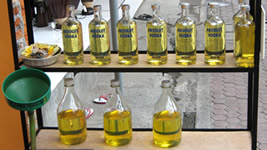 Bali is held together by bits of string. That’s how it sometimes feels anyway. The geography of the island, plus the rugged nature of some of the roads, combined with the fact that many people ride motorbikes with small petrol tanks, accounts for the prevalence of roadside petrol racks. These have been the savior of many a locals and expat alike, who for some reason, forgot to fill up before they left home. The owners of these racks charge a higher price than the petrol station, (5,000rp per liter) and the now familiar Absolut bottle is the receptacle of choice. Large wine jugs serve as containers for 2 liters of fuel. My 100cc bike can hold just over 3 liters, so I’m good to go after paying 15,000rp at a roadside petrol rack.
Bali is held together by bits of string. That’s how it sometimes feels anyway. The geography of the island, plus the rugged nature of some of the roads, combined with the fact that many people ride motorbikes with small petrol tanks, accounts for the prevalence of roadside petrol racks. These have been the savior of many a locals and expat alike, who for some reason, forgot to fill up before they left home. The owners of these racks charge a higher price than the petrol station, (5,000rp per liter) and the now familiar Absolut bottle is the receptacle of choice. Large wine jugs serve as containers for 2 liters of fuel. My 100cc bike can hold just over 3 liters, so I’m good to go after paying 15,000rp at a roadside petrol rack.
The advantages of using these racks are time, as you are the only customer and convenience as they can be found all over. The negatives are price and fuel quality, as they mix in other things to compound their margin. Quite often I find petrol racks on side streets, with bottles more generously filled than those on the main street. Locals know this, so take the time to pull off of the road. Tourists and expats often couldn’t care less and fill up anytime they feel like it.
Tips on using a petrol rack include having the correct change. Presenting a large bill, might mean you loose your time saving, when the vendor has to go door to door for small money. Also make sure you check the price, before telling the guy to fill up. Bali is dusty, so I try not to open my tank, which is located under the seat, until the vendor is ready with the funnel. Many petrol sellers also own a compressor, enabling you to 1-stop-shop. Getting both tires pumped will cost 1,000rp and is a good way of boosting mileage.